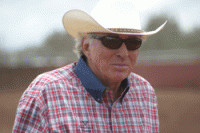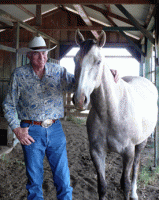Hawaii’s Modern Paniolos


An Interview with a Paniolo Hall of Fame Inductee
by Equitrekking host Darley Newman
Doesn’t being born and raised riding horses on the island of Oahu sound dreamy? That’s what I thought as I listened to Michael “Corky” Bryan tell me about his childhood on Ewa Plantation on Oahu. From a young age, Corky always knew that he wanted to be a cowboy, and his dream came true. He’s been a cowboy his entire life and now rides at one at the Big Island’s most historic western enclaves, Parker Ranch.
During my trip to ride on the Big Island, I was able to explore Parker Ranch on horseback. It is a vast, working ranch in the shadow of Mauna Kea volcano. Tens of thousands of cattle roam the ranch under a big blue sky dotted with constantly moving clouds. The ranch is located in Waimea, cowboy country on the Big Island, where paniolos, Hawaiian cowboys, still do pass on their skills to future generations.
I asked Corky more about life for cowboys on Parker Ranch and what life is like for modern paniolos.
Below are excerpts from my recent interview with Corky, who was a 2007 inductee into the Paniolo Hall of Fame.
Darley: What kind of work do cowboys do at Parker Ranch?
Corky: Right now we have 12, including our cowboss, you know our operations manager. So there are 12 of them that handle all the cattle work. They are what we’d call horsemen or what you’d call cowboys. Then we have another 10 guys that kind of make them look good that fix the fences and water pipes. Not that the cowboys don’t do that too, but most of what we call support work is done by a support group of 10 guys.
Darley: And now these 12 cowboys… are there still things that they do that we would consider more traditional type cowboy work?
Corky: Oh yeah, they do very traditional type work. They’re out. They’re the ones that move the cows, wean the calves, brand the calves, or do any of that kind of stuff. They all have a string of 6 to 8 horses and an ATV and cell phone and a pickup truck, so they have everything they need, we hope, to get the job done that they need to get done.
Darley: Are they still involved in round-ups?
Corky: Oh yeah, we have cow herds anywhere from- our smallest cow herd is about 250 cows and we have a cow herd that’s about 1400 to 1500 cows- so yeah, they still have to bring the cows in to wean them. We put the bulls out and we bring the bulls in. You know, there’s a lot of times when they’re on horseback all day long, for sure.
Darley: So they have their cell phones now, but they’re still on horseback?
Corky: Yes. Because we have big country and these guys are alone a lot, it’s always a good thing to have that phone just in case something happens and they need help. You know it’s a communication situation and safety situation more than anything else.
With 12 guys and 20,000 cattle, each guy has got to handle a lot of their own cattle and most of these guys are responsible for areas that are bigger than most ranches.
Darley: How would you describe the vibe around Waimea?
Corky: It has a lot to do with the fact that the town was a ranch town to begin with, when it started, and even up through the 1950’s and the late 60’s. Then in the 70’s and 80’s it started changing. A lot of people started moving here, but we still have the open spaces and you can see cows on the hills and along the highway. That creates the ambience that people move up here for.
Darley: So you were inducted into the Paniolo Hall of Fame? That’s cool.
Corky: Don’t remind me. You know it’s one of those things. It’s a good news bad news deal, right? Good news is that your in. Bad news is that means you’re old.
Darley: What makes a paniolo different from cowboys on the mainland?
Corky: A paniolo is similar to a cowboy on the mainland. They do very similar things. Some of the differences were early on when we were shipping cattle. We had to swim cattle to a boat and that kind of thing… We’re a little more casual here. A lot of our guys wear tank tops and ballcaps, but the ballcaps are because we have so much wind in this country. There’s a lot of subtle traditions that are different that are unique to Hawaii. You know the saddles are different. Our saddles are basically an offshoot of the Mexican saddles. The Mexicans, the vaqueros, came here to teach the Hawaiians how to cowboy, and so a lot of their traditions carried on. A lot of our guys still use the tapaderos (hoods that cover the stirrups, usually made of leather and on traditional Mexican saddles) that were part of that vaquero tradition.
The vaquero saddle doesn’t have that much leather on it. What we do is we use rawhide to wrap around the horns and hold up the reins on the saddle. It’s a braided rawhide deal called the aweawe. That’s a throwback to Mexican saddle. There’s very little leather on it. In a lot of the country that we have here, there was a lot of rain and there still is, so you don’t want to have to worry about getting the saddle damaged and leather was expensive here, so the least amount of leather the better.
Darley: Yes, that makes sense. It’s a more tropical environment. How have things changed on the ranch. What was it like for cowboys years ago?
Corky: Back then, like everywhere else, there were no trucks and trailers, so when they went up to do a big job, and they had these huge paddocks, they would ride one horse up an maybe lead two or three and drive a bunch of horses up to wherever they were going to go work. During shipping time, they were up in the morning at 2 o’clock in the morning and then walking cattle 10 miles down to the port to ship them out. We didn’t even have electricity in this town until the army came in the 1940’s, so it was pretty rustic for quite a while here.
Darley: How do you find the cowboys now that you hire?
Corky: Most cowboys have been here 10 years or more. We have two younger guys that have been here for two or three years and most of those are third or fourth generation cowboys. A lot of them are here because, somebody in their family was a cowboy, not necessarily here but somewhere else. One fellow that we have now, he was actually born in one of the houses here and his dad worked here for many years and then his great, great grandfathers were cowboys at a neighboring ranch so… That’s where we like to get them. These guys- we don’t have to teach them much of anything- just procedures and that sort of thing pretty much, and they can do it all because they’ve been cowboying since they could walk. We try to find those kinds or younger guys that have been cowboys all of their lives and are willing to learn.
With 12 guys and 20,000 cattle, each guy has to handle a couple thousand cattle a piece and most of these guys are responsible for areas that are bigger than most ranches.
Corky, like many horse enthusiasts, will be at this weekend’s Parker Ranch rodeo and enjoying many of the activities put on by the Paniolo Preservation Society during 2008, the Year of the Paniolo. As he says, he’s “living the dream.”




